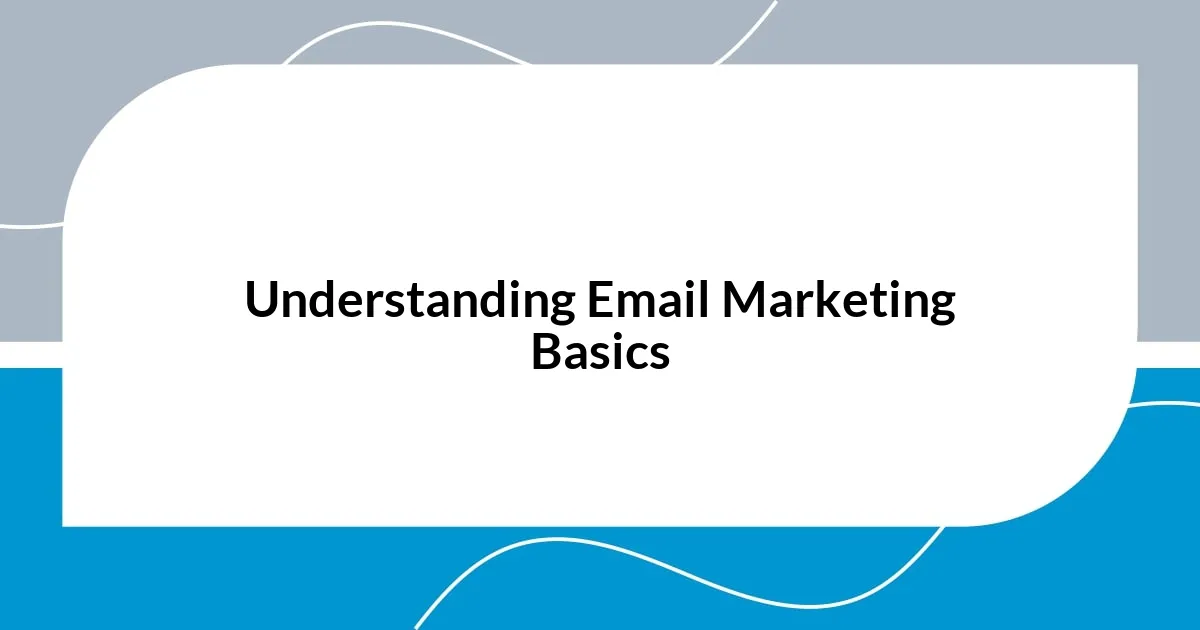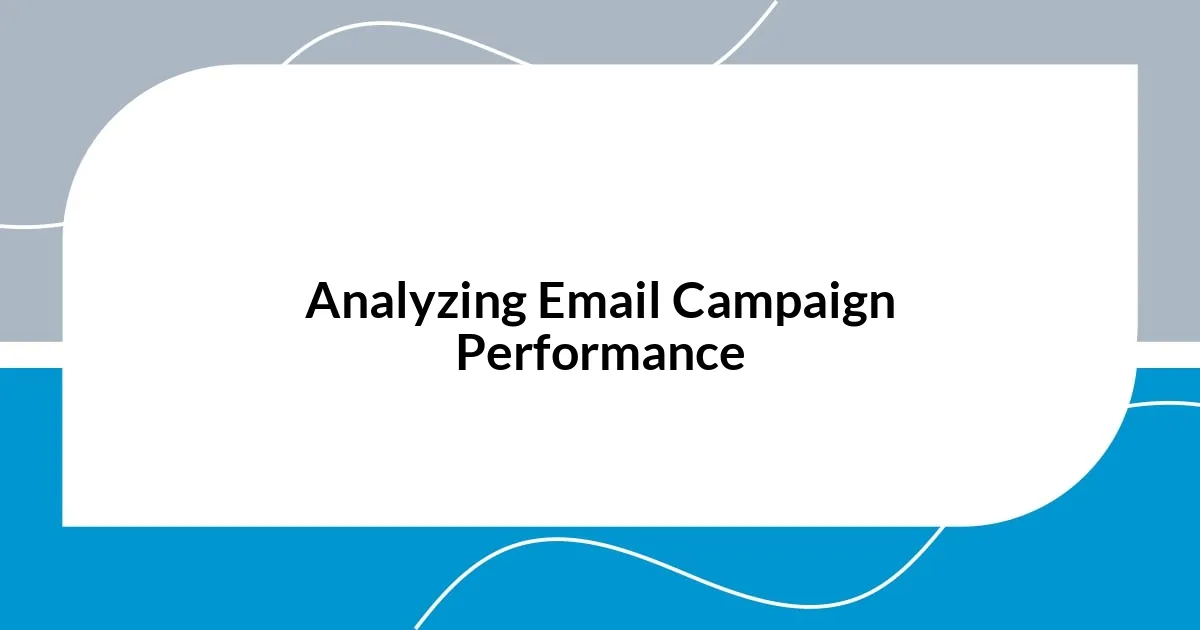Key takeaways:
- Personalization and segmentation are crucial for effective email marketing, resulting in increased engagement and trust.
- Building an engaging email list involves offering valuable incentives and maintaining regular communication to enhance subscriber retention.
- A/B testing small elements (like subject lines and call-to-action buttons) can significantly impact campaign performance and engagement rates.
- Implementing automation strategies, such as welcome email series and drip campaigns, can enhance the subscriber experience and foster stronger relationships over time.

Understanding Email Marketing Basics
Email marketing is more than just sending messages; it’s about creating genuine connections with your audience. I remember the first time I crafted a campaign that felt personal. I used recipient names and tailored content to their preferences. The result? A noticeable increase in open rates that surprised me! It made me realize how impactful personalization can be in an email.
Understanding the basics involves knowing that effective email marketing hinges on delivering the right message at the right time. Have you ever opened an email that perfectly addressed your needs in that moment? I certainly have, and it sparked a sense of trust. That trust is what encourages subscribers to engage with your brand over time, leading to stronger relationships and increased sales.
Moreover, segmentation is a crucial aspect that can’t be overlooked. I learned this the hard way when I sent the same email to my entire list, only to find the response was dismal. By dividing my audience into specific groups based on their behaviors and interests, I saw engagement soar. It’s like having a conversation with someone who truly gets you—so rewarding!

Building an Engaging Email List
Building an engaging email list is truly an art. I still remember setting up my first opt-in form and feeling a mix of excitement and nervousness. What really stood out was how I offered a valuable incentive, a well-designed eBook, which encouraged people to subscribe. That strategy not only filled my list but also felt like a mutual exchange—how satisfying it was to deliver something valuable in return for their interest!
As I grew my list, I discovered the importance of maintaining regular communication. Sending a delightful welcome email was my way of setting the right tone. It was almost like throwing a little party for new subscribers. Engaging them from the start led to higher retention rates. I was thrilled to see how a simple greeting could make them feel valued and excited about future content.
Lastly, I’ve found that nurturing relationships over time is key. Engaging with subscribers isn’t a one-off event; it’s an ongoing dialogue. I often ask for feedback, and you wouldn’t believe the insightful responses I get. That two-way interaction not only builds loyalty but also helps in tailoring content that truly resonates. Isn’t it wonderful how a conversation can evolve over time, just like friendships?
| Strategy | Impact |
|---|---|
| Offering Valuable Incentives | Encouraged sign-ups and established trust |
| Sending a Welcome Email | Increased engagement and subscriber retention |
| Nurturing Relationships | Built loyalty and improved content relevance |

Crafting Compelling Email Content
Crafting compelling email content is where the real magic happens in email marketing. One lesson that stands out from my experience is the importance of subject lines. I vividly recall a campaign where I switched from a bland subject like “Newsletter Update” to a more intriguing “Unlock Exclusive Tips Inside!” The difference was staggering. That single word change not only piqued curiosity but also boosted my open rates significantly.
To create captivating emails, I now focus on a few key elements:
- Personalization: Tailor the content to speak directly to individual preferences.
- Engaging Stories: Share relatable anecdotes that draw readers in—like the time I discovered a unique application for my product.
- Strong Call to Action (CTA): Use clear, inviting language that guides readers on what to do next, such as “Join our community today!”
By embracing these strategies, I turn every email into an opportunity for connection rather than just a digital message. It’s about crafting content that resonates and encourages interaction. Each email is not just a task on my to-do list but a chance to engage—and I relish that!

Optimizing Email Timing and Frequency
Optimizing the timing and frequency of emails can significantly enhance your engagement rates. I learned early on that sending emails at strategic times could make or break a campaign. For instance, I noticed that my open rates peaked when I sent emails on Wednesday afternoons. The feeling of satisfaction when I cracked that code? Unforgettable! It’s like finding that perfect time to meet a friend—you just know it’ll lead to a great conversation.
When it comes to frequency, I’ve experimented a lot to find the sweet spot. Too many emails can overwhelm my audience, while too few can lead them to forget who I am. I settled into a rhythm where I send out a weekly newsletter with curated content and occasional special offers. This approach not only keeps the communication fresh but also ensures my audience looks forward to my emails. Wouldn’t you agree that anticipation can boost engagement?
I also discovered the value of testing and refining my strategy continuously. A/B testing has become my best companion in this journey. By sending two variations of an email—one in the morning and the other in the evening—I could assess which timing achieved better open rates. It’s fascinating how small tweaks can lead to big results. Have you ever tried adjusting your email schedule? The insights gained can be truly eye-opening and empowering for your future campaigns!

Analyzing Email Campaign Performance
Analyzing the performance of my email campaigns has been a game-changer in refining my approach. I remember the excitement I felt after receiving my first analytics report—seeing those open and click-through rates was like stepping into a new dimension of understanding my audience. It prompted me to ask: What resonates? What falls flat? Digging into these metrics revealed patterns that opened my eyes to how I could better engage my readers.
I often break down my results by segmenting my audience based on their behaviors. For example, I once noticed that a specific demographic was clicking on links related to product tutorials more than others. This revelation led me to tailor content specifically for them, drastically boosting engagement. I can’t stress enough how these insights shape my future campaigns. Have you ever tailored content based on audience behavior? It might feel daunting, but the reward is incredible when you realize you’re speaking directly to people’s interests!
Moreover, I actively track metrics over time to understand the broader trends influencing my success. One year, I noticed that customer feedback complemented my data analysis perfectly; when open rates dipped, I sought direct feedback through surveys. The responses informed me that subscribers felt overwhelmed with content. That prompted me to create lighter, more digestible content. This cycle of feedback and analysis not only increased my responsiveness but also deepened my connection with my audience. Isn’t it fascinating how a simple analysis can lead to a more profound relationship?

A/B Testing for Better Results
A/B testing has truly revolutionized the way I approach email campaigns. I remember the first time I tried it—I sent out two different subject lines to see which would grab more attention. The sheer thrill of watching one subject line outperform the other in real-time was exhilarating! It was like sneaking a peek at your friend’s exam paper just before the results come out. Have you ever experienced that rush of anticipation?
What I’ve discovered is that even the tiniest change can yield remarkable results. For instance, I once switched the call-to-action button color from blue to green in my emails, thinking it was merely an aesthetic choice. To my surprise, that little tweak led to a significant increase in click-through rates! It’s a testament to how even subtle modifications can resonate differently with your audience. Have you experimented with your button designs? It might just be the game-changer you need.
The beauty of A/B testing is its ability to foster a mindset of continuous improvement. I’ve come to think of it as a journey rather than a destination. Recently, I tested the content length of my emails—one was concise and punchy, while the other was more detailed. Analyzing the results revealed that my audience preferred a more conversational tone with images over lengthy text. Can you imagine uncovering such a preference? It’s moments like these that keep me passionate about email marketing; the learning never stops, and that’s what makes this journey so fulfilling!

Implementing Automation Strategies
Implementing automation strategies in my email marketing was a revelation. The first time I set up a welcome email series for new subscribers was a game-changer for me. I remember how rewarding it felt to know that the moment someone signed up, they would receive a thoughtfully crafted welcome message automatically. Have you ever considered how much personal touch you can create without lifting a finger after the initial setup?
One critical aspect I learned about automation is segmentation. By creating specific lists based on interests or behaviors, I was able to send tailored messages at the right time. For instance, I automated birthday greetings with a special discount offer for subscribers. The joy I felt when I noticed the spike in engagement during birthday weeks was incredible! This strategy made my subscribers feel valued and more connected to my brand.
As I delved deeper into automation, I began to experiment with drip campaigns. The idea of guiding subscribers through a journey over time rather than overwhelming them with one-off messages resonated with me. I often reflect on how my first series—providing helpful tips and resources spaced out over a few weeks—created a sense of anticipation among my audience. Did you know that nurturing your audience gradually can lead to stronger relationships? I learned that over time, each email built upon the last, fostering trust and expectation. It was like unfolding a compelling story, and I was eager to see how it would end!